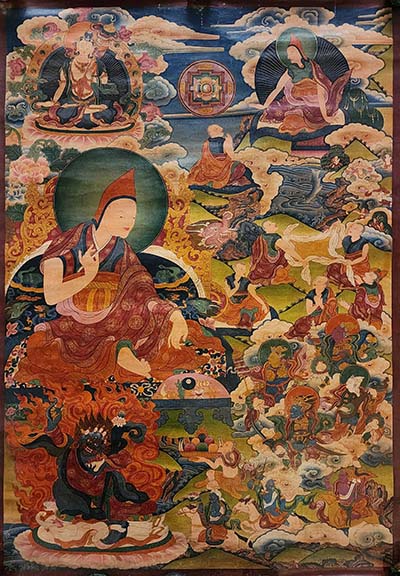Loading Content..

Atisha Dipankara Shrijnana, commonly known as Atisha, was a revered Buddhist scholar and teacher who played a significant role in revitalizing Buddhism in Tibet during the 10th and 11th centuries. His teachings had a profound impact on Tibetan Buddhism, leading to a revival of spiritual practice and understanding in the region. Atisha's arrival in Tibet in 1042 CE marked a turning point for the Buddhist tradition in the country.
Alternative Names:
Common Name: Atisha
Tibetan Name: ??????????????????????????????????? (A-ti-sha Reje Ngönpa Chenpo'i Zhel Dam)
Chinese Name: ?? (Cháng Xián)
Iconography:
There is no specific iconography associated with Atisha as a deity. He is typically depicted as a revered Buddhist scholar and teacher, often portrayed in traditional monastic robes, seated in a meditation posture or engaged in teaching.
History:
Atisha was born in Bengal (present-day Bangladesh) in 982 CE. He received comprehensive Buddhist education and became a renowned scholar. Atisha's teachings emphasized the practice of bodhicitta (the mind of enlightenment) and the cultivation of compassion. His arrival in Tibet was a response to the invitation of the Tibetan king, Lha Lama Yeshe Ã, who sought to revive and restore Buddhism in his kingdom.
Temples and Monasteries:
While there are no specific temples or monasteries dedicated solely to Atisha, his teachings are widely revered and practiced in various Buddhist monastic institutions and centers around the world. In Nepal, you can find numerous monasteries and centers where his teachings are studied and followed, such as Ka-Nying Shedrub Ling Monastery and Shechen Monastery.
Benefits of Practicing Atisha's Teachings:
Practicing the teachings of Atisha brings numerous benefits to practitioners. These include:
Cultivating compassion and loving-kindness towards all beings.
Developing wisdom and insight into the nature of reality.
Awakening the mind of enlightenment (bodhicitta) and striving for the benefit of all sentient beings.
Overcoming negative emotions and cultivating positive qualities.
Establishing a strong foundation for spiritual growth and progress on the path to liberation.
How to Practice Atisha's Teachings:
To practice Atisha's teachings, one can engage in the following practices:
Studying Atisha's treatises and commentaries on Buddhist philosophy and meditation.
Cultivating compassion through practices such as loving-kindness (metta) meditation.
Engaging in ethical conduct and moral discipline.
Developing mindfulness and awareness through meditation and contemplation.
Engaging in practices of generosity and benefiting others.
Mantra of Atisha:
There is no specific mantra associated with Atisha as a deity. However, practitioners often recite the mantra of Avalokiteshvara, the bodhisattva of compassion, as a means of invoking compassion and blessings, which aligns with Atisha's teachings.
Loading..
Please wait for the page to fully load for optimal functionality.
Loading Content..